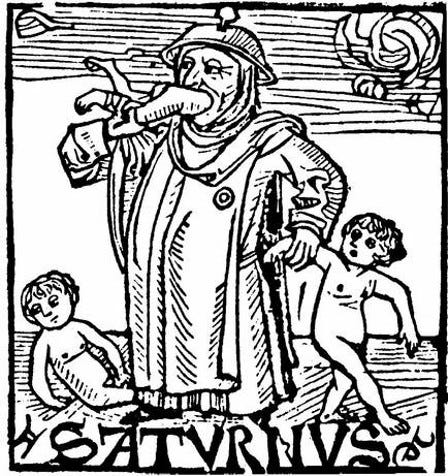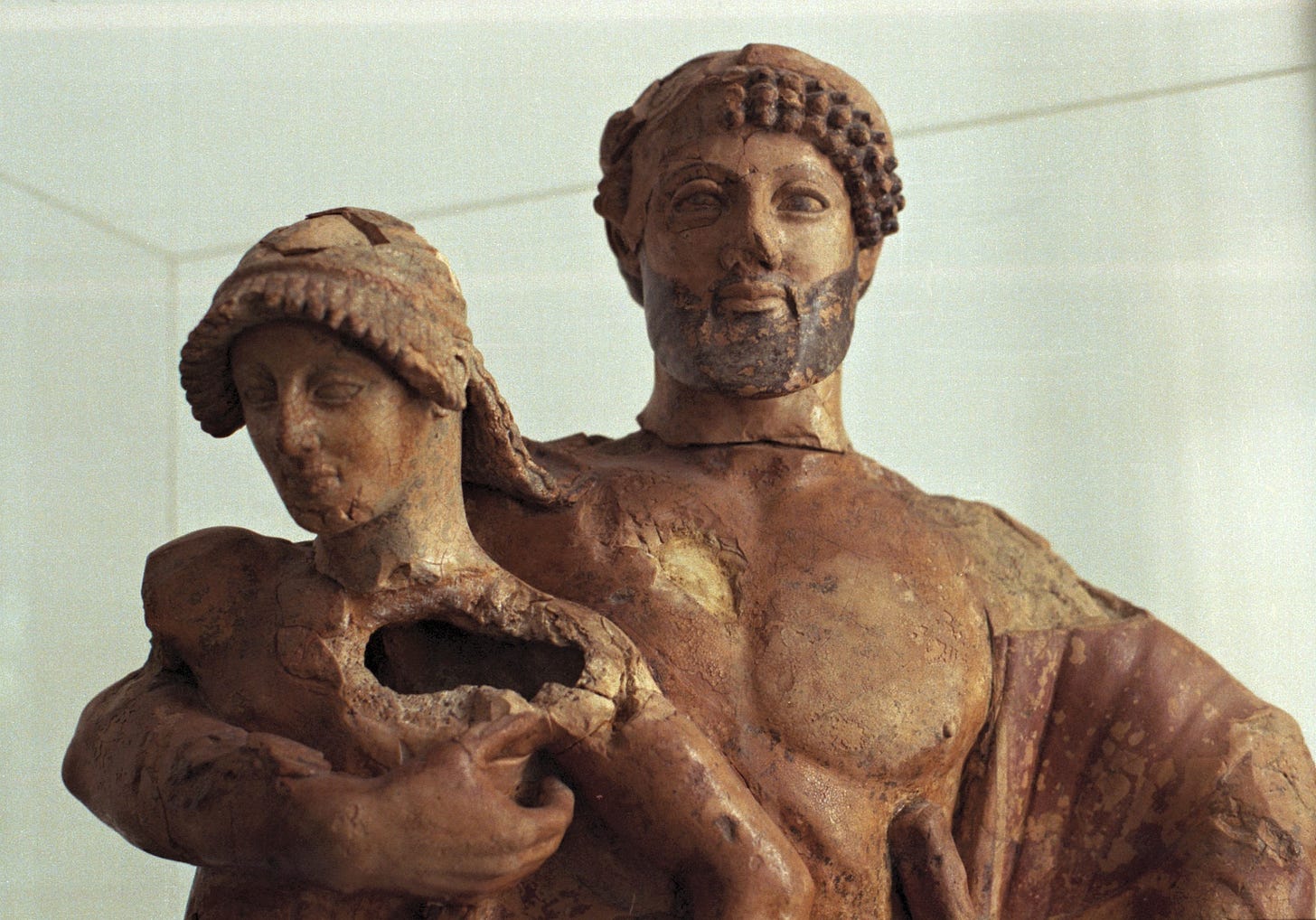America's Puer Problem Has Turned Into Its Senex Syndrome
An exploration of Trump-Musk through the lens of the Senex-Puer archetype
“We are living in what the Greeks called the kairos – the right moment – for a ‘metamorphosis of the gods,’ of the fundamental principles and symbols. This peculiarity of our time, which is certainly not of our conscious choosing, is the expression of the unconscious man within us who is changing. Coming generations will have to take account of this momentous transformation if humanity is not to destroy itself through the might of its own technology and science.”
— C. G. Jung, The Undiscovered Self
America’s Puer Problem
In the quivering post-coital reverberations of Elvis and the Beatles shaking their respective hips and mop-tops on live television, American culture gave birth to a new generation of “flower children” whose rallying cry was “I hope I die before I get old.” In this nascent Age of Aquarius, “youth” emerged as a category and identity that represented a renewed spirit of freedom and unlimited possibilities, while “old” was rightfully associated with patriarchal oppression and outdated cultural norms. Youth was in, out with the old.
Archetypologists will note that Aquarius is the constellation attributed to Ganymede, the mythic hero who served as cup-bearer to Zeus, and who is associated with the archetype of the puer aeternus or “eternal boy.”
In the years that followed the Summer of Love, psychologists and sociologists wrote extensively about what Jungian analyst Marie-Louise Von Franz identified as “The Problem of the Puer Aeternus” in her 1970 book of that name. She describes the puer man as someone who “remains too long in adolescent psychology; that is, all those characteristics that are normal in a youth of seventeen or eighteen are continued into later life, coupled in most cases with too great a dependence on the mother.” This archetype, first identified by Jung through his study of world myth and religion, is associated with mythic figures such as Icarus, the aforementioned Ganymede and Adonis, and the youthful tricksters Hermes and Loki.
Von Franz goes on to describe the qualities of a puer-identified man as flighty, idealistic, promiscuous, with a “terrific fear of being pinned down.” He’s a “mama’s boy” whose relationship with women is distorted by the idealized image of his own mother, which he projects onto his romantic partners until the spell is inevitably broken. Von Franz writes, “each time he is fascinated by a woman he has later to discover that she is an ordinary human being. Once he has been intimate with her the whole fascination vanishes and he turns away disappointed, only to project the image anew onto one woman after another. He eternally longs for the maternal woman who will enfold him in her arms and satisfy his every need.”
Trump-Musk & The Shadow of Saturn
I had started out writing this essay with the intent to show how Trump and Musk embody the qualities of the puer and that America is still suffering from a puer problem, but as I gathered examples of their puerness (of which there are many) I realized that something wasn’t quite right. Something was being left out. As I analyzed their recent behaviour, it occurred to me that while they may present as typical pueri on the surface, their actions reflected more of the puer’s opposite, the senex.
Senex is the Latin word for “old man” and the archetype is most identified with the god Saturn/Cronus. Like every archetype it has a dual nature. The positive attributes of the senex are those that we attribute to the benevolent king or wise sage — maturity, wisdom, mentorship, reliability. Gandalf or King Arthur are great examples. In its negative expression the senex is cold, hardened in its ideas, authoritarian, obsessed with borders, history and maintaining conventional structures. Think of the sick and tyrannical king figures in various contemporary stories from Game of Thrones to Succession.
We get our words senior, senate, seniority and senile from senex, so the archetype is commonly associated with old age. But as James Hillman points out, because senex is an archetype native to the psyche, it’s in us from the beginning. He describes how the senex is expressed in the small child “who knows and says “I know” and “mine” with the full intensity of its being, the small child who is the last to pity and first to tyrannize, destroys what it has built, and in its weakness lives in oral omnipotence fantasies, defending its borders and testing the limits set by others.”
While Von Franz broke new ground with her in-depth analysis of the puer problem, she failed to pair the puer with the senex. It was Hillman’s later developments that introduced the insight that the puer and senex are two poles of the same archetype. Just as “Mother-Child” are two parts of a whole, in that one can’t really exist without the other, so it is with the archetype of “Old-Young”.
The Senex-Puer Split
With this understanding, we can look back and see that one of the outcomes of the cultural revolution of the 1960s was a splitting of the senex-puer archetype. Hillman was prescient when he spoke at the 1967 Eranos lectures that the division has shown up “in the political world with its aging leaders and systems attempting to maintain “law and order,” and the rebellions of youth in the name of “rights and freedom.” As one legal philosopher has put it: never in the history of the United States have we had so many laws, so much science of law and its enforcement, and never have we had so much disorder and violence.”
While the rise of the revolutionary puer brought great social change — women’s liberation, civil rights, technological innovation — it came with a denigration of the senex, which had become associated with its most negative qualities — patriarchy, authoritarianism, resistance to change. As both Freud and Jung have shown, this kind of one-sidedness always leads to a return of the repressed in monstrous form, and that’s what I believe we’re seeing now with the second Trump administration and the re-emergence of nationalism and authoritarianism throughout the West.
It seems to me the tipping point, or enantiodromia as Jung called it, happened in 2016 when Trump first took office, and the growing authoritarianism started to show itself (perhaps counter-intuitively) among the liberal left. While the left displayed a lot of puer qualities in their outward expression — think of the pink pussy hats, the tantrums of blue-haired SJWs and the demolition of patriarchal monuments — behind it all loomed the dark shadow of senex authoritarianism.
I believe that it was this shadow authoritarianism of the left and the havoc it wrought over the next seven years — peaking in the COVID lockdowns, civilians policing their neighbours, oppressive political correctness etc. — that triggered a defensive counter-response from the other side.
In this not-so-great turning, we saw Elon Musk go from liberal techno-utopian to right wing watchdog, currently being set loose upon the US government and tearing it apart like a rabid DOGE. His newly-adopted adolescent dress and puer persona are meant to divert our attention away from the raging senex that’s been awakened inside of him. While it is tempting to attribute Elon’s wacky behaviour to his obviously real puer problem, we have to remember that the 10th century Arabic text Picatrix describes Saturn, the god in the senex, “master of all artifice, deceitful.”
When I recently had an offline chat with Jung and Hillman scholar Glen Slater about my idea to write an archetypal analysis of Trump and Musk, he suggested that Trump’s trolling and lies were an expression of the trickster puer, but I’m not so sure. My sense is that the puer’s trickster behaviour is part of his revolutionary tendency on behalf of the renewal of the world. Trump’s deceitfulness feels to me more cold, calculated and sinister, more Saturnian. It’s not about making America great in a way it’s never been great before, but about making America great again. “Saturn was the ruler of the Golden Age when men had abundance of all things.” Ring any bells?
But what makes this all so shadowy and thus hard to see, is that both Elon and Trump clearly identify with and project the puer who never really wants to grow up, let alone grow old and die. My first draft of this essay included extensive examples that would be obvious to anyone with the slightest knowledge of the puer’s qualities — their obsession with phallic rockets and skyscrapers, their megalomania, their issues with women, their love of showing off — but what emerged from my exploration was something far more intriguing and hard to pinpoint so easily, and that is their shadowy expression of the senex.
You can see the senex-puer split explicitly in their outward presentation. In his second term Trump is carrying all the senex energy, while Musk is free to play the puer. But behind the scenes looms the negative senex.
One of the reasons the senex is so hard to identify is due to the distance, duality and paradox that is inherent to the archetype. (Remember that Saturn was the outermost planet of the classical world.)
The Two Sides of Saturn
Hillman writes of the dual nature of the senex and his ruling god Saturn, “According to the Warburg Institute’s authoritative study of Saturn, in no Greek god-figure is the dual aspect so real, so fundamental, as in the figure of Cronus, so that even with the later additions of the Roman Saturn who “was originally not ambivalent but definitely good,” the compounded image remains at core bipolar. Saturn is at once archetypal image for wise old man, solitary sage, the lapis as rock of ages with all its positive moral and intellectual virtues, and for the Old King, that castrating castrated ogre. He is the world as builder of cities and the not-world of exile. At the same time that he is father of all he consumes all; by living on and from his fatherhood he feeds himself insatiably from the bounty of his own paternalism. Saturn is image for both positive and negative senex.”
In Saturn & Melancholy (1964) the authors write about the duality of Saturn/Cronus who is “… a benevolent God of agriculture … the ruler of the Golden Age when men had abundance of all things … and the building of cities” and at the same time “the god of death and the dead. On the one hand he was the father of gods and men, on the other hand the devourer of children, eater of raw flesh, the consumer of all, who ‘swallowed up all the gods’.”
The bipolarity of the senex is reflected in the ambivalence toward Trump-Musk expressed by so many of the people I talk to. On one hand, Elon has built incredible technologies and “fathered” numerous successful companies. But these bright ideas, like all bright ideas, cast a long shadow. Something that’s not talked about enough is how Tesla, Space X and Elon’s Artificial Intelligence projects all require a titanic amount of resources to sustain them. “At the same time that he is father of all, he consumes all.” Saturn/Cronus as the great builder but also the eater of children.
As Jungian analyst James Hollis pointed out to me in an email exchange, “part of the senex of Trump is that he is perfectly willing to pull down the house around him as his legacy, thereby expressing his rage that he, too, must pass shortly.” Laying waste to social support systems and trade alliances is the political version of devouring your children. It’s not called predatory capitalism for nothing.
Trump-Musk: Pseudo-Pueri?
Musk’s bright ideas might, at first glance, seem like classic puer forward-thinking. But there’s nothing really new about them, nothing groundbreaking or revolutionary. They’re totally retro, which comes from the French retrograde, to step backwards. Self-driving cars, colonizing Mars and cyborg implants were all fantasies first imagined in the science fiction of the 1940s and 50s. There’s something rather senex about his drive to concretize these fantasies, to convert them from flights of fancy to material “reality.”
If you’re able to see through all the surface goofiness, puerile memes and infantile name-calling by Trump-Musk, you might hear the cold, distant voice of old Saturn calling for us to toughen up, tighten up, suck it up. When I hear with my archetypal ear the constant mindboggling use of numbers by the Trump administration to justify their calculated, unfeeling actions I’m reminded that Saturn rules over money and measurement. As Hillman writes, he is the “principle of coagulation and of geometrical order, (he) dries and orders, “builds cities” and “mints money,” makes solid and square and profitable, overcoming the dissolving wetness of soulful emotionality.” Facts not feelings. Order at the expense of soul.
Healing the Bipolar Disorder
At this point you might be asking, “Ok so what? What’s the point of all this Saturnian analysis?”
In these moments of crisis, I think it’s imperative to cultivate some psychological awareness of the underlying archetypal forces at play, at both the individual level and cultural level. I’ve started thinking of this as “archetypal intelligence” or A.I. Cultivating archetypal intelligence is important if we want to first, avoid becoming possessed by an archetype through the triggering of our unconscious complexes, and second, gain some insight into what archetypes need to be recovered and brought into play to balance the scales when they’ve tipped too far in one direction or the other. The usual tendency is to think that we need to move things in the opposite direction, to correct the imbalance, from right to left, or left to right. But what tends to happen is the kind of manic bipolarity that I’ve attempted to highlight in this essay. We see-saw from one extreme to the other. Instead, we need to work on healing the split, which can only happen when we have some psychological awareness of the forces at play.
In an interview with Laura Pozzi, first published as Inter Views (1983), Hillman cautions us against any ideas of integration or union of opposites, suggesting instead something like the Renaissance idea of gloria duplex, “keeping the consciousness of both sides. The danger lies in splitting the duplex into only senex or only puer. Exclusive. One turned against the other. We had one-sided puer in the sixties, and now that chaotic style of destruction is giving way to programmed style of senex destruction – political repression, armaments, CIA – in the name of economics and security, which are senex ideals. If gloria duplex sounds too old-fashioned, too Italian for you, then what about our little syllable “re”? It takes the old and gives it a puer twist. It turns things back and turns things upside down at the same moment.”
When Laura presses him for a more practical answer on re-uniting senex and puer, Hillman responds in his typical puer style, “I think first we have to watch out for anything simple. Simplifications are already part of the rhetoric of one or another side of the split. Gloria duplex means complicated answers, not many single answers lined up as alternative scenarios. When we complicate in the right way we begin to force imagination to work. Simplification stops the imagination … as we imagine the world, as we imagine our historical problems, they begin to be interiorized, they begin to be psychological. But it isn’t we who make those complications – it’s the psyche, the anima. That’s what anima does – messes things up, blurs the edges. She gets things tangled – isn’t that what “plicated” means, folded?
So the beginning of a puer-senex reunion means letting the anima get at both sides, letting the dried-out senex feel soul again, little bits of moisture, little gipsy fantasies, and letting the high-flying, fire-eating puer feel inferior and moody and confused. A little lonely and outcast and misunderstood like the senex. It’s so hard to realize that big pathological problems can have fuzzy solutions, pathological solutions.”
As an archetypal tarot-ologist, I can’t help but see Hillman’s formulation of the healing of the Senex-Puer split via Anima in the progression of the major arcana, from Fool to Hermit to World (Anima Mundi). One of the things I love about the tarot is how it illustrates via archetypal images the complexity of the journey toward wholeness, and how the end game isn’t some kind of monotheistic fantasy of unity, but rather an inclusionary vision of the diversity of the “self.”
So there you have it. An appropriately fuzzy solution to a fuzzy problem. What I hope to inspire in you, rightfully troubled reader, is some reflection on your relationship to these archetypes and healing the split(s) within your selves. Because in the end, it’s our relationship to (paraphrasing WH Auden) “the forces that live through us” that will ultimately determine the fate of our respective nations.
…
Brian James is a depth counsellor and host of the Howl in the Wilderness podcast. Learn more at brianjames.ca
Go Deeper
The Sibling Society, Robert Bly
Senex & Puer, James Hillman Uniform Editions Vol. 3
The Puer Papers, edited by James Hillman, Spring Publications
Senex & Puer audio lectures from BetterListen (also available on Spotify)












This is excellent, I’m so enjoying these posts.